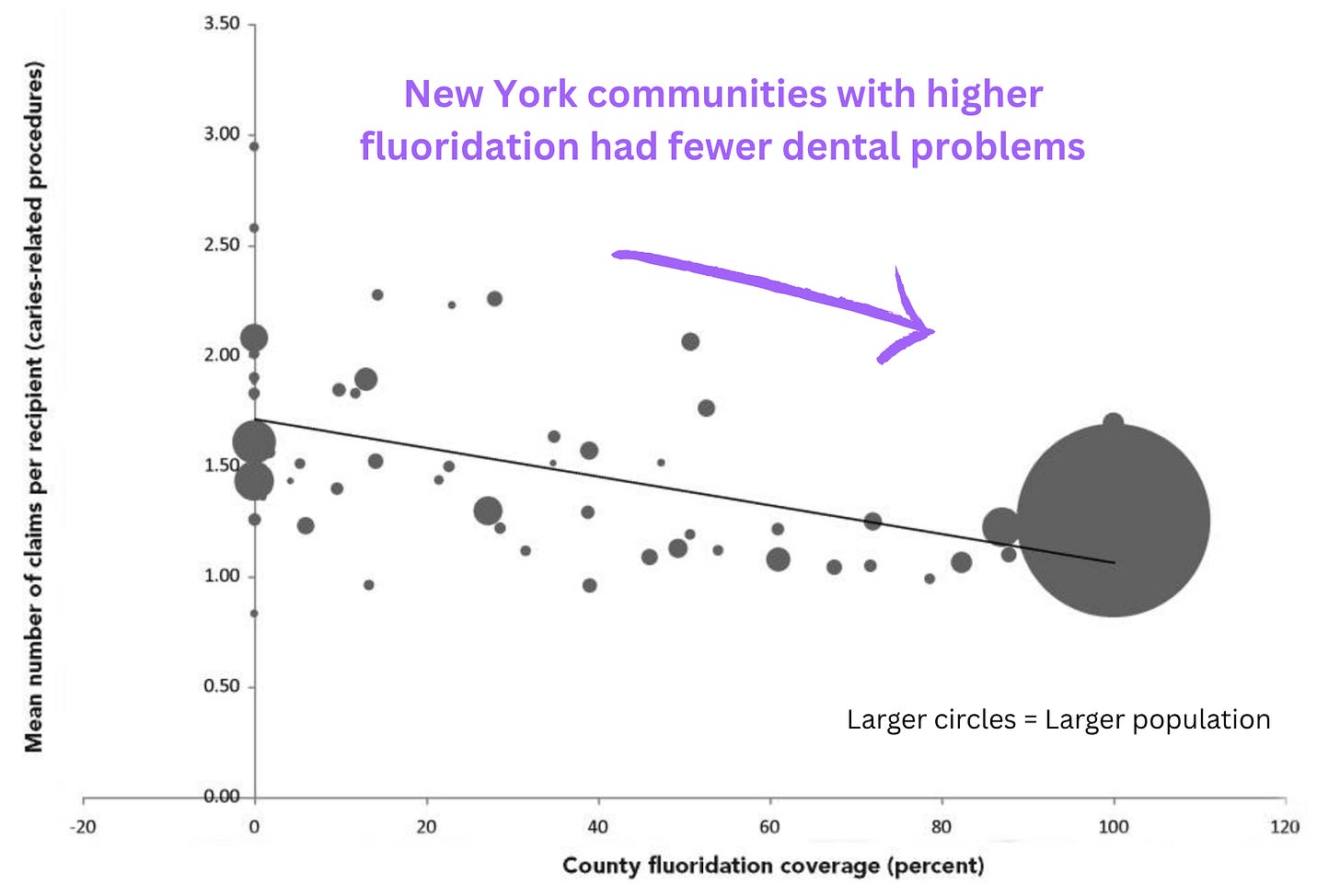There is a national debate on whether we should continue adding fluoride to drinking water. (YLE National covered this in the fall.) However, policy is not mandated at the federal level—whether you have fluoride in your water (and at what levels) is largely determined by states and local communities. Utah banned fluoride last month. Could bans be coming to New York? And what is currently happening here?
Fluoride 101: a quick refresher
Fluoride is a naturally occurring mineral found in water, soil, air, and some foods. Since the 1940s, many U.S. communities have added fluoride to drinking water to strengthen teeth and prevent cavities.
Think of it like calcium for bones—fluoride helps integrate into tooth enamel, making teeth stronger, more durable, and more resistant to decay.
Health organizations—including the CDC, WHO, American Dental Association, and American Academy of Pediatrics—all support community water fluoridation as a safe and effective public health strategy.
What’s happening in New York?
While federal agencies, such as the EPA, set upper safety limits, whether your water is fluoridated depends on local decisions.
New York City has fluoridated its water since 1960.
Most New York counties add fluoride, covering about 60–70% of New Yorkers.
Some counties, like Suffolk, Nassau, and Rockland (large counties bordering NYC), have chosen not to fluoridate their water.
In New York and across the U.S., fluoride in drinking water has led to major improvements in dental health. The New York State Department of Health and the State University of New York conducted a study in 2010 to examine the effects of community water fluoridation on tooth decay in New Yorkers. They found that dental procedures for tooth problems were 33.4% higher in counties with less fluoride

The core debate: dose matters
It’s important to know: while fluoride is beneficial at the right levels, excessive fluoride can be harmful—just like with vitamins or minerals.
Excessive fluoride exposure over years can impact bones, causing increased bone density and joint pain.
Fluorosis is the cosmetic staining of teeth at excessively high fluoride levels, though this is extremely rare at fluoride levels seen in New York.
Some studies have also associated excessive fluoride consumption with cognitive development issues, but the evidence doesn’t hold up for typical U.S. water fluoridation levels.
But, there are a number of safety measures in place to ensure excessive fluoridation doesn’t happen:
Environmental Protection Agency (EPA) requires that drinking water contain no more than 4 milligrams per liter. Above this limit, fluoride-associated bone issues become a greater risk.
State regulations from New York State. New York is even stricter than the EPA, limiting it to no more than 2.2 milligrams per liter, which is significantly lower than the federal limits.
CDC recommends the optimal level is 0.7 milligrams per liter.
In New York, our water is tested multiple times per day, every day, and in 2024, not a single water sample’s fluoride levels ever exceeded 0.8 milligrams per liter.
All this to say: the level of fluoride in New York drinking water is safe, is a successful public health strategy to reduce dental problems, and won’t have harmful health effects.
Why keeping fluoride matters: health equity
If you regularly see a dentist, fluoride in drinking water shouldn’t be too big of a concern. However, many people lack access to or cannot afford a dentist.
There are disparities in oral health. In 2023, the American Dental Society found that only one in three dentists nationally accept Medicaid, the health insurance for lower-income families. CDC estimates that children in lower-income families have nearly three times higher rates of untreated cavities than children in higher-income families. Visible signs of poor dental health can cause stigma and shame, and poor dental health can also lead to chronic illnesses, like heart disease and diabetes.
While we don’t have recent data, a 2005 survey found that 60% of New York 3rd-grade children in low-income families had tooth decay, compared to a lower rate of 48% in high-income families. Even though they are supposed to have annual check-ups, about 94% of children on Medicaid in New York State under 3 years of age, and 62% of those between 3 and 5 years of age, did not receive any dental care in 2009.
The amount of fluoride in our New York drinking water is not enough to cause harm, but removing it would likely lead to dental issues in groups who don’t have good access to dentistry. Fluoride in drinking water serves as a safety net for those who don’t have dental resources.
What you can do
Most public water systems in New York have been adding fluoride to drinking water for decades. With years of evidence for benefit, I don’t see a big movement to dismantle these systems in New York.
Ultimately, questions may come up at the local level, and the decision to fluoridate will continue to be made on a county-by-county basis. This year in New York City, Mayor Adams essentially entrusted the health department with the decision to continue water fluoridation, and they are in favor of maintaining it. I’ll be watching, though, to see if his policies change in the coming months as he campaigns for re-election.
If questions come up around fluoride in your community, there are a couple of things you can do:
Check your local water report to know your community’s fluoride levels.
Ask your dentist about fluoride toothpaste, especially for kids.
Stay informed, and don’t hesitate to ask community health experts questions about your water. If fluoride is removed from drinking water, it will be important that communities develop alternative programs that protect dental health in lower-income families.
Bottom line
Fluoride in New York’s drinking water is safe, regulated, and has clear benefits with small risks. Removing fluoride could worsen dental health disparities, especially for children and lower-income families who don’t have ready access to dentists. All kids should have healthy smiles, and water fluoridation is one way to help achieve that.
Love,
Your New York Epi




